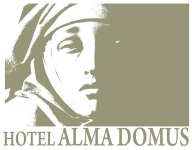
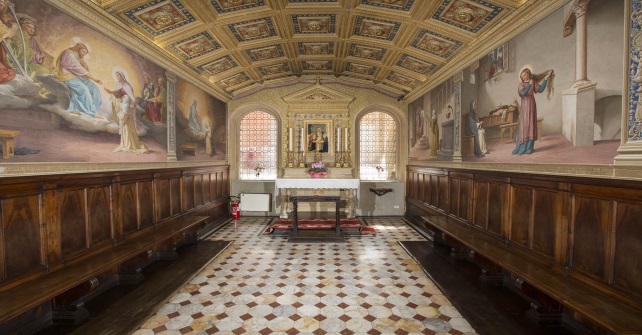


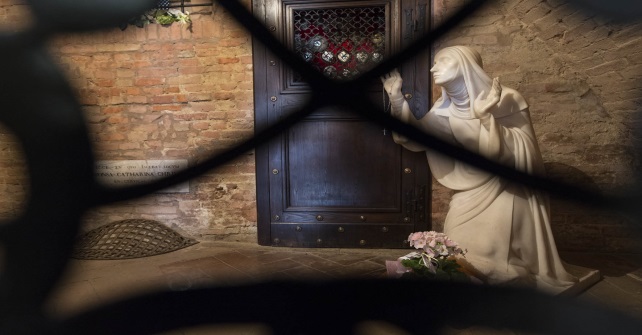
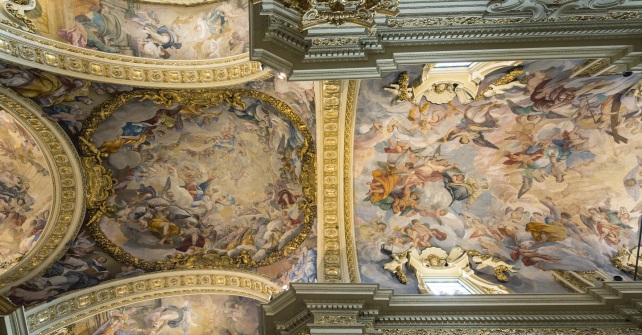
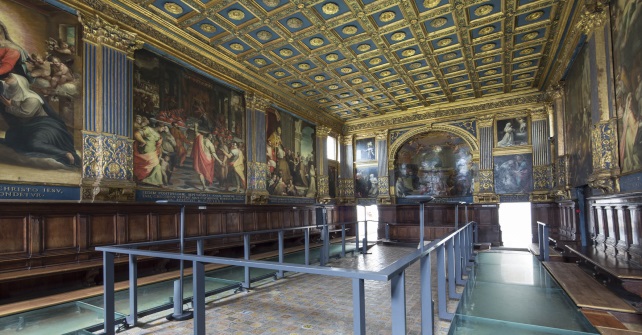
At the beginning of the XVII century, from 1614-23, the Church of the Sacred Crucifix was built within the Sanctuary-house of St Catherine of Siena in what was considered to have been the garden of the Benincasa family. At the time of construction it was named the 'Oratory of the Sacred Crucifix', as it was originally intended for the use of the cult of the crucifix preserved within its walls, which was reserved for members of the Lay Fraternity of St Catherine. At the time the Lay Fraternity was already busy with the construction of the 'Oratorio della Cucina' and the 'Oratorio della Cameretta' in what was once the origional nucleus of St Catherine's family home. From 1611 on, the members of the fraternity began to notice the need for an adequate space in which to house and display the wooden crucifix attributed with having given St Catherine invisible stigmata of light in the Church of Santa Christina in Pisa in 1375. The crucifix was the fraternity's most prized posession ever since it first came into their hands in 1565, the year in which it was brought from Pisa to the 'Oratorio della Camera'. This, however, was not a satisfactoy solution to the problem of where to house the crucifix, as the Oratory was too small, especially during festivals in honour of the saint. On the 23rd of Arpile 1623, the church was consacrated with a solemn procession, and on the 21rd of may of the same year the crucifix was placed upon its altar after a long procession through the most important parts of the city. Construction continued right throughout the 17th century, resulting in considerable variation from the origional plans. Today, the interior of the church appears completely baroque; its single unified space is typical of that style, and is in complete harmony with the ceiling frescoes from the early 18th century by G.N Nasini. On the walls behind the choir is a precious high altar in polycrome marble by Tommaso Redi from 1649 which, on the other hand , is more similiar to works of the late 18th century, thanks to the exquisite details in the workmanship of the stuccoes on the pediment and the numerous cherubs and festoons that really make this altar stand out as a high point of Siense 18th century interior design. The altar is like a jewel box, jealously guarding the wooden crucifix, itself from the Pisan school of the 12oos. The crucifix stands within a portale with fine gilt engraving on its doors, which open to reveal works depicting St Catherine and St Bartolomeo by Bartolomeo di Bastiano Neroni, known as 'Il Riccio' (1505-1571), who was also responsible for the decorative scheme of the 'Oratorio della Cucina'. As the crucifix itself testifies, the iconographic scheme of the frescoes develops around the theme of the stigmata and glorification of St Catherine. However, in the later canvases, placed in the church in the second half of the 18th century, scenes from the Saint's life prevail, along with the themes of St Catherine's devotion to her fellow men and her involvement in ecclesiastical politics. Upon entering, we are confronted with four large canvas in the central nave. On the right St Catherine is attacked by Florentine soldiers in a painting by Galgano Perpignani from 1765, and gives charity to the poor in one by Liborio Guerrini dating 1777; On the left hang scenes of the Pope's return to Rome by Niccolò Franchini from 1769, and St Catherine imploring the Pope on his return to Rome (1768) by Alessando Calvi (known as 'Il Mutolo'). In the walls of the transept, above the left altar, we see St Catherine before the Pope by Sebastiano Conca, and over the right altar hangs the exaltation of St Catherine by Rutilino and Domenico Manetti. This last work was painted in 1638, just a few years after St Catherine's stigmata were officially acknowledged, and so it may therefore be considered one of the first depictions of the apotheosis of St Catherine. In the lateral walls of the choir beside the high altar, there are another two paintings; one portraying the ecstasy of St Catherine on the right, and, on the left, Saint Catherine writing inspired by St Thomas and St John. Both works are by the Sienese artist Giuseppe Nicola Nasini, who also painted the frescoes which embellish the oratory's vaults and dome in 1701-03. They concentrate on the glorification of St Catherine, and, in particular, her stigmata.
Storia
Storia
Storia
Storia
Storia
Storia
